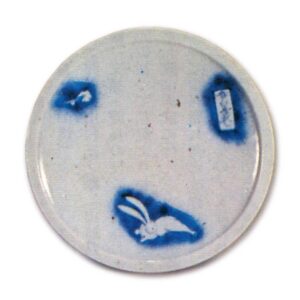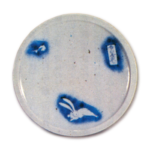
This term refers to the variegated colors that appear as if ink has been sprayed on the surface.
This technique was probably first used in Ming dynasty China. The Hyakumagama kiln began to use this technique in the gai-kuma style using stencils, and a similar technique can be seen on oil dishes of Seto in the early modern period. Another interesting example of fuboku technique other than kosotsusuke is the work of Eiraku Wazen.
Fukiage Etsuke (Fukiage Painting)
A method of painting by blowing powdered pigment plaster under air pressure to form a fine mist that adheres to the ceramic area to be painted, and then adjusting the shade of the mist as desired. The pattern can be obtained by attaching a patterned paper pattern or thin tin foil to the part of the vessel to be painted, then blowing a fine mist over it, and later removing the paper pattern. By applying two or three layers of different patterns, spraying with pigments, and then removing the pigments one after the other, the perspective of the pattern can be easily created. The result is a beautifully finished product, and is a revolution in the traditional Japanese ceramic painting method. The most convenient method of atomizing pigment plaster using compressed air is the eirograph, the most commonly used atomizer, which is a simple cylindrical sealer that stores compressed air. The eirograph has a variety of holes, both large and small, with different structures and uses, and can be skillfully interchanged to create a variety of patterns. The eirograph can also be used to apply colored glaze plaster to the surface of ceramics while gradually rotating the vessel to apply glaze in any shade, making it a very convenient method.








